
Spittal an der Drau is a town in the western part of the Austrian federal state of Carinthia. It is the administrative centre of Spittal an der Drau District, Austria's second largest district (Bezirk) by area.

Dunkelsteinerwald is a market municipality with 2,289 inhabitants in the district Melk in Lower Austria, Austria.

Lienz is a medieval town in the Austrian state of Tyrol. It is the administrative centre of the Lienz district, which covers all of East Tyrol. The municipality also includes the cadastral subdivision of Patriasdorf.

Mittersill is a city in the federal state of Salzburg, Austria, in the Pinzgau region of the Alps. It is located on the Salzach River. It has a population of 5,408 as of 2011.
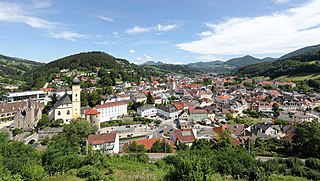
Waidhofen an der Ybbs is an independent city (Statutarstadt) in the Austrian state of Lower Austria. The city had a population of 11,662 as of the 2001 census. It was first mentioned in 1186 and has been the economic centre of the Ybbstal valley since the 14th century.
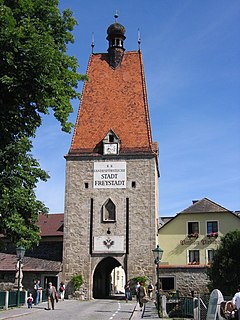
Freistadt is a small Austrian town in the state of Upper Austria in the region Mühlviertel. With a population of approximately 7,500 residents, it is a trade centre for local villages. Freistadt is the economic centre of a district of the same name District Freistadt. The nearest sizeable cities are Linz, the capital of Upper Austria, about 40 km in the south, and České Budějovice, the capital of Southern Bohemia, about 60 km in the north.

Feldbach is a town in the southeast of the Austrian state of Styria, near the Slovenian and Hungarian border. It is located in the valley around the river Raab.

The ruins of Aguntum are an ancient Roman site in East Tirol, Austria, located approximately 4 km east of Lienz in the Drau valley. The city appears to have been built to exploit the local sources of iron, copper, zinc and gold. During the early Christian era, the city was the site of a bishopric, which, having ceased to be a residential diocese, is today listed by the Catholic Church as a titular see.
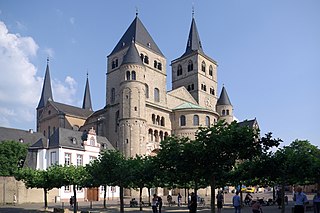
The High Cathedral of Saint Peter in Trier, or Trier Cathedral, is a Roman Catholic cathedral in Trier, Rhineland-Palatinate, Germany. It is the oldest church in Germany and the largest religious structure in Trier, notable for its long life span and grand design. The central part of the nave was built of Roman brick in the early fourth century, resulting in a cathedral that was added onto gradually in different eras. The imposing Romanesque westwork, with four towers and an additional apse, has been copied repeatedly. The Trier Cathedral Treasury contains an important collection of Christian art. In 1986 the church was listed as a UNESCO World Heritage Site, as part of the Roman Monuments, Cathedral of St. Peter and Church of Our Lady in Trier.
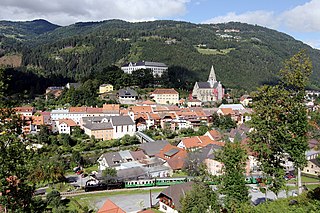
Murau is a town in the western part of the Austrian federal state of Styria. It is the administrative seat of Murau District.

Potzneusiedl is the smallest village in the district of Neusiedl am See in Burgenland in Austria.

Lesachtal is a municipality in Hermagor District, in the Austrian state of Carinthia. It comprises the western part of the eponymous valley formed by the upper Gail River, and stretches from the Carinthian border with East Tyrol down to Kötschach-Mauthen in the east.

Moosburg is a market town in the Klagenfurt-Land district in the Austrian state of Carinthia.

Oberdrauburg is a market town in the district of Spittal an der Drau at the western rim of the Austrian state of Carinthia.

Bad Sankt Leonhard im Lavanttal is a spa town in the district of Wolfsberg in the Austrian state of Carinthia.

Sillian is a market town in the district of Lienz, in the Austrian state of Tyrol.
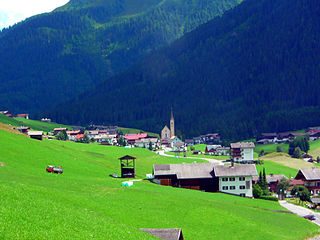
Kartitsch is a municipality in the district of Lienz in the Austrian stateof Tyrol.

Obertilliach is a municipality in the district of Lienz, in the Austrian state of Tyrol.

Steinach am Brenner is a market town in the district of Innsbruck-Land in the Austrian state of Tyrol located south of Innsbruck in the Wipptal at the Sill River.
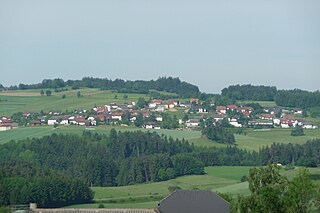
Waldburg is a municipality in the district of Freistadt in the Austrian state of Upper Austria.


























